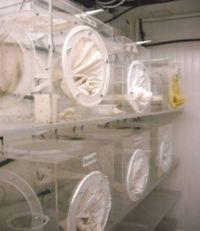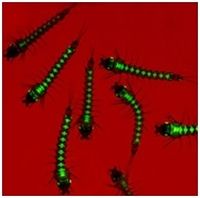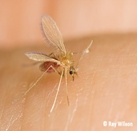NEW RESEARCH TOOLS
8 new distributable mosquito colonies (2018-19)

Colony cages in insectary
- Newly initiated from the natural population
- With microbiome and genetic variation data
- With user-friendly genetic fingerprint test for colony authentication
- Aedes aegypti aegypti, New Caledonia
- Aedes aegypti formosus, Senegal
- Aedes albopictus, France
- Anopheles atroparvus, Spain
- Anopheles coluzzii, Mali
- Anopheles darlingi, French Guyane
- Anopheles funestus, Burkina Faso
- Culex pipiens, England
New distributable hard tick colony (2018-19)
- Hyalomma marginatum, vector of Crimean-Congo Hemorrhagic Fever virus
New distributable Plasmodium falciparum lines (2018-19)

Malaria infected cells (©Institut Pasteur)
- From different geographic populations
- Gametocyte-producing clonal lines adapted for culture and mosquito infection
- Sequenced, with genetic fingerprint test for authentication
Infravec2 recommends that researchers obtain arbovirus stocks at no cost from the EU-funded European Virus Archive, EVAg
- EVAg virus stocks are authenticated and quality controlled
Improved vector reference genome assemblies

Illumina® sequencing instrument (©Illumina Inc.)
- Many vector reference genomes are fragmented and poorly annotated
- Infravec2 will improve reference genomes of two vector species
- Species chosen for public health significance, expected positive research impact of new genome tools, and absence current improvement project for the species.
- Anopheles darlingi: major human malaria vector in South America
- Phlebotomus perniciosus: European sandfly vector of Leishmania and emerging human arboviral diseases caused by phleboviruses
- Sequencing, assembly and long range mapping will be used to resolve gaps and improve sequence quality
Distributable vector genetic editing tools for Aedes aegypti & Anopheles coluzzii

Transgenic Anopheles larvae (©University of Glasgow)
- CRISPR/Cas9 tools for targeted gene disruption
- Mosquito lines with docking sites for integration of transgenes
Develop and disseminate an experimental infection system for sandfly infection with emerging arboviruses

Sandfly species (©Ray Wilson)

Sandfly species (©Ray Wilson)
- Viruses transmitted by sandflies (phleboviruses) are an emerging public health threat in Europe and elsewhere, but research tools are lacking
- Develop and disseminate standard conditions for experimental sandfly infection (Phlebotomus perniciosus) with model phlebovirus (Toscana virus, Bunyaviridae)
- Improve Phlebotomus perniciosus genome assembly to aid functional studies of sandfly-virus interactions
